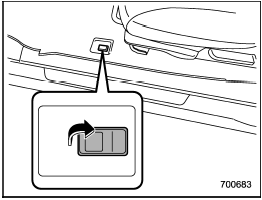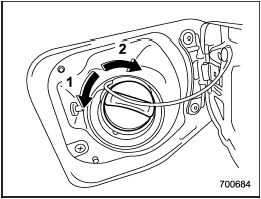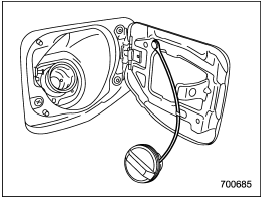 Subaru Forester: Refueling
Subaru Forester: Refueling
Only one person should be involved in refueling. Do not allow others to approach the area of the vehicle near the fuel filler pipe while refueling is in progress.
Be sure to observe any other precautions that are posted at the service station.


1. To open the fuel filler lid, pull the lid release lever up. The lever is on the floor at the left of the driver’s seat.

Before opening the fuel filler cap, first touch the vehicle body or a metal portion of the fuel pump or similar object to discharge any static electricity that may be present on your body. If your body is carrying an electrostatic charge, there is a possibility that an electric spark could ignite the fuel, which could burn you. To avoid acquiring a new static electric charge, do not get back into the vehicle while refueling is in progress.

1) Open
2) Close
2. Remove the fuel filler cap by turning it slowly counterclockwise.

- Gasoline vapor is highly flammable.
Before refueling, always first stop the engine and close all vehicle doors and windows.
Make sure that there are no lighted cigarettes, open flames or electrical sparks in the adjacent area. Only handle fuel outdoors.
Quickly wipe up any spilled fuel.
- When opening the cap, grasp it firmly and turn it slowly to the left. Do not remove the cap quickly. Fuel may be under pressure and spray out of the fuel filler neck, especially in hot weather. If you hear a hissing sound while you are removing the cap, wait for the sound to stop and then slowly open the cap to prevent fuel from spraying out and creating a fire hazard.

3. Hook the cord that is attached to the fuel filler cap onto the hook inside the fuel filler lid.

- When refueling, insert the fuel nozzle securely into the fuel filler pipe. If the nozzle is lifted or not fully inserted, its automatic stopping mechanism may not function, causing fuel to overflow the tank and creating a fire hazard.
- Stop refueling when the automatic stop mechanism on the fuel nozzle activates. If you continue to add fuel, temperature changes or other conditions may cause fuel to overflow from the tank and create a fire hazard.
4. Stop filling the tank after the fuel filler pump automatically stops. Do not add any more fuel.
5. Put the cap back on, turn it clockwise until you hear a clicking noise. Be certain not to catch the tether under the cap while tightening.
6. Close the fuel filler lid completely.
If you spill any fuel on the painted surface, rinse it off immediately. Otherwise, the painted surface could be damaged.
NOTE
- You will see the “ ” sign in
the fuel
gauge. This indicates that the fuel filler
door (lid) is located on the right side of
the vehicle.
” sign in
the fuel
gauge. This indicates that the fuel filler
door (lid) is located on the right side of
the vehicle.
- If the fuel filler cap is not tightened until it clicks or if the tether is caught under the cap, the CHECK ENGINE warning light/malfunction indicator lamp may illuminate. Refer to “CHECK ENGINE warning light/Malfunction indicator lamp”.

- Never add any cleaning agents to the fuel tank. The addition of a cleaning agent may cause damage to the fuel system.
- After refueling, turn the cap to the right until it clicks to ensure that it is fully tightened. If the cap is not securely tightened, fuel may leak out while the vehicle is being driven or fuel spillage could occur in the event of an accident, creating a fire hazard.
- Do not let fuel spill on the exterior surfaces of the vehicle. Because fuel may damage the paint, be sure to wipe off any spilled fuel quickly. Paint damage caused by spilled fuel is not covered under the SUBARU Limited Warranty.
- Always use a genuine SUBARU fuel filler cap. If you use the wrong cap, it may not fit or have proper venting and your fuel tank and emission control system may be damaged. It could also lead to fuel spillage and a fire.
- Immediately put fuel in the tank whenever the low fuel warning light illuminates. Engine misfires as a result of an empty tank could cause damage to the engine.
 State emission testing (U.S. only)
State emission testing (U.S. only)
At state inspection time, remember to
tell your inspection or service station in
advance not to place your SUBARU
AWD vehicle on a two-wheel dynamometer.
Otherwise, serious transmission
damag ...
See also:
If your engine overheats
In any of the following situations, you can reduce the
potential for overheating your engine by taking the
appropriate action.
• On the highways — slow down.
• In city traffic — while ...
Important safety notes
The rear view camera is an optical parking aid. It shows the area behind your
vehicle in the COMAND display.
WARNING
Make sure that no persons or animals are in the maneuvering range. Otherwi ...
With USB/iPod® mode selected
Press the “” button to skip
forward in the
track/file order. Press the “”
button to
skip backward in the track/file order. The
track/file number will be shown on the
audio display. ...

